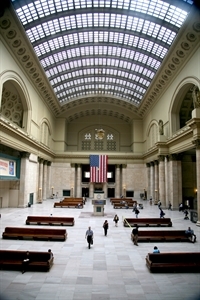
Photo by The West End via flickr
Changes are in the works for Chicago's Union Station.
History is repeating itself at Chicago Union Station. The need for a state-of-the-art, centralized rail hub in Chicago became an important issue around the turn of the last century, when railroad heads and city leaders agreed that the overcrowded 1881 Grand Passenger Station – which required passengers to walk to smaller stations for connecting trains – was no longer acceptable. $75 million and 12 years of construction later, Union Station was unveiled. Its double-stubbed tracks, ability to house multiple lines under one roof, and underground U-shaped driveways were heralded as cutting edge in transit innovations, but 86 years later, Union Station is again at the crux of a push for a more unified transportation center. The 2011 version of that vision includes track modifications to decrease train transfers, as well as improved access to Metra’s Ogilvie Transportation Center and the Chicago Transit Authority’s (CTA) El system. These changes are necessary because:
- Union Station’s platforms, tracks, and passenger spaces are often at capacity during peak periods, limiting growth potential for future commuter rail and high speed intercity passenger rail services.
- Union Station currently has a limited number of run-through tracks. This means that many rail passengers traveling to points beyond Union Station must change trains to reach their final destinations.
- Ogilvie is separated from Union Station by three city blocks, with no off-street pedestrian connection between them.
- Passengers who want to connect to the CTA El from Union Station also must walk outdoors for two to three blocks to the east or southwest.
These shortcomings may be manageable if you don’t mind overcrowding and delays, if you know the city, if it’s not pouring rain or blowing snow, and if you don’t have a heavy bag and/or children to carry. But these are big “ifs” – and notable deficiencies that are not acceptable in a world-class, 21st Century transportation hub.
The Chicago Dept. of Transportation (CDOT) and other regional transportation agencies - including Amtrak, Metra, and CTA - agree. In 2010, CDOT engaged an engineering and design consulting team led by TranSystems to develop future alternatives for Union Station. Two steering committees have been organized: a Technical Advisory Committee, of which MPC is a member; and a Civic Advisory Committee, chaired by MPC committee members Linda Goodman and Jorge Perez. Through the work of the consultants and these committees, several different potential station configuration concepts are being developed. All options would increase capacity for both passengers and trains, improve connections between all modes of transit (CTA, Metra, and Amtrak), and explore public-private partnerships for financing the undertaking.

Great Hall at Chicago's Union Station
Photo by Vincent Desjardins via flickr
In addition to the technical aspects of the station’s reconfiguration, the best reuse of Union Station’s Great Hall is another item being discussed. Designed by Daniel Burnham in the years leading up to his death in 1912, the station is one of only about a dozen Beaux-Arts railroad stations in the country. Its Great Hall is one of the United States’ great interior public spaces, but it presents challenges for adaptive re-use to effectively serve today’s travelers and commuters. MPC would like to see its redesign framed in light of Placemaking principles, which favor the creation of vibrant public spaces and have the potential to transform an imposing historic structure into one that invites interaction with its users and surrounding city.
In the next phase of planning, the project participants will model the alternatives by simulating pedestrian behavior and train operations for each scenario. Scheduled to begin in late 2011, these further studies are expected to last 12 to 18 months.
Read more about the history of Chicago Union Station here,in this article from Railroad History, the journal of the Railway & Locomotive Historical Society. Read Railway Age Gazette articles on Union Station from 1912 and 1925.